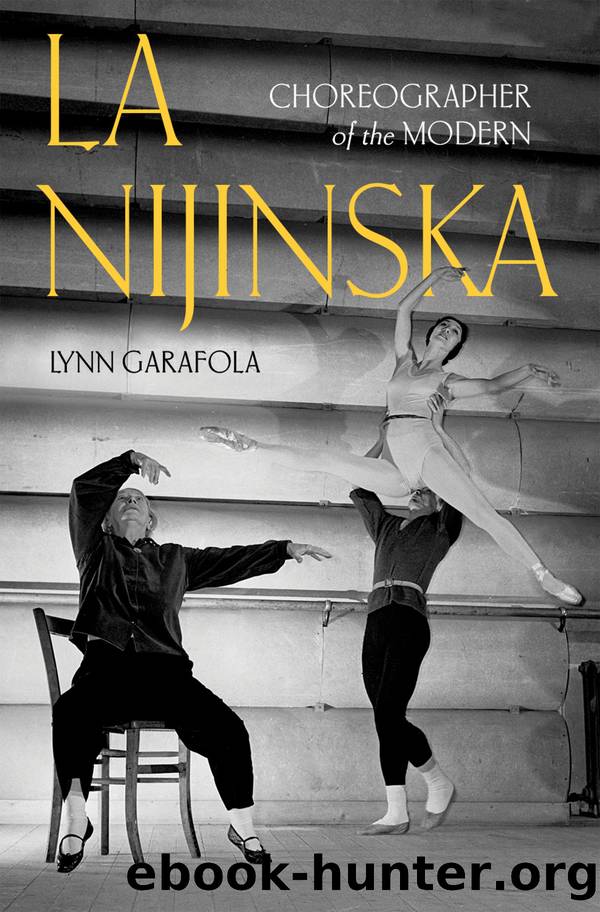La Nijinska by Lynn Garafola

Author:Lynn Garafola
Language: eng
Format: epub
Publisher: Oxford University Press
Published: 2021-06-15T00:00:00+00:00
The term âpantomimeâ was much bandied about in reviews of the ballet, and not favorably, given the widespread acceptance of Levinsonâs notion of ballet as âpureâ dance. Brillant sought to refute this prejudice by placing Hamlet within the context of eighteenth-century theory of the ballet dâaction. This, Brillant explains, is âa drama or comedy in silence, a ballet that tells its story without words and in which, by necessity, gesture and pantomime have a part and sometimes a very big part,â which for those who believe that ballet first and foremost is dance is âheresy.â139 In Hamlet, Brillant argued, Nijinska was following the tradition of Jean-Georges Noverre and being attacked, as he had been, for dispensing with âtechnique.â âEntrechats,â Brillant declared, âhave no part in the tragic adventures of the Danish prince.â140
Some critics found themselves unexpectedly drawn into the mysterious heart of the work. âA poignant emotion reignsâ throughout the final tableau, Albert Lestray wrote in La Liberté, âand one follows with passion the evolutions of the dancers who, by their precise gestures, render the most complex and beautiful feelings.â141 Henry Malherbe singled out Nijinskaâs âarresting imageâ as Hamlet and Ruth Chanovaâs âpenetrating charmâ as Ophelia.142 Max Frantel, a writer and man of letters who reviewed the ballet for Comoedia, was enchanted by Annenkovâs âstylizations . . . on transparent hangingsâ and the balletâs âexpressive atmosphere above all for the death of Ophelia.â143 As for Brillant, he left two snapshots of Nijinska. In one she is handsome and melancholy, in the other pale, feverish, and tragic: in both she is dressed all in black and seemingly beyond gender categories.144
A few days later in Figaro, Reynaldo Hahn savaged not only Hamlet but Nijinskaâs undertaking in general.
Dance Hamlet? Why not? Does any subject exist with a chance of escaping the choreographic mania of Russians and their imitators? . . . You will see that little by little . . . they will adapt, orchestrate, choreograph, decorate, costume, dance, and mime Pascalâs Pensées, Czernyâs exercises, . . . Palestrinaâs Masses, Ciceroâs speeches, . . . Molièreâs Misanthrope, and the railroad timetableâthis at least could give rise to picturesque evocations. But all these efforts would not be equally happy, and this is the case of Hamlet. Reduced to a slender plastic scheme, the âTragic History of Hamlet, Prince of Denmark,â has no mystery, grandeur, or any meaning. Decors that at first delight the eye . . . soon tire it by a preference for smokiness . . . ; a pantomime so vague, so âstylizedâ that a spectator ignorant of what is going on can understand nothing; a musical accompaniment . . . played, so to speak, without having been rehearsedâthis is the ânoveltyâ intended as a treat for the Parisian public by the Ballets Russes at the Châtelet.145
Download
This site does not store any files on its server. We only index and link to content provided by other sites. Please contact the content providers to delete copyright contents if any and email us, we'll remove relevant links or contents immediately.
Call Me by Your Name by André Aciman(20376)
Ready Player One by Cline Ernest(14527)
How to Be a Bawse: A Guide to Conquering Life by Lilly Singh(7394)
Wiseguy by Nicholas Pileggi(5674)
The Kite Runner by Khaled Hosseini(5085)
On Writing A Memoir of the Craft by Stephen King(4864)
Audition by Ryu Murakami(4851)
The Crown by Robert Lacey(4731)
Call me by your name by Andre Aciman(4621)
Gerald's Game by Stephen King(4584)
Harry Potter and the Cursed Child: The Journey by Harry Potter Theatrical Productions(4440)
Dialogue by Robert McKee(4326)
The Perils of Being Moderately Famous by Soha Ali Khan(4171)
Dynamic Alignment Through Imagery by Eric Franklin(4118)
Apollo 8 by Jeffrey Kluger(3637)
Seriously... I'm Kidding by Ellen DeGeneres(3577)
The Inner Game of Tennis by W. Timothy Gallwey(3575)
How to be Champion: My Autobiography by Sarah Millican(3557)
Darker by E L James(3480)
